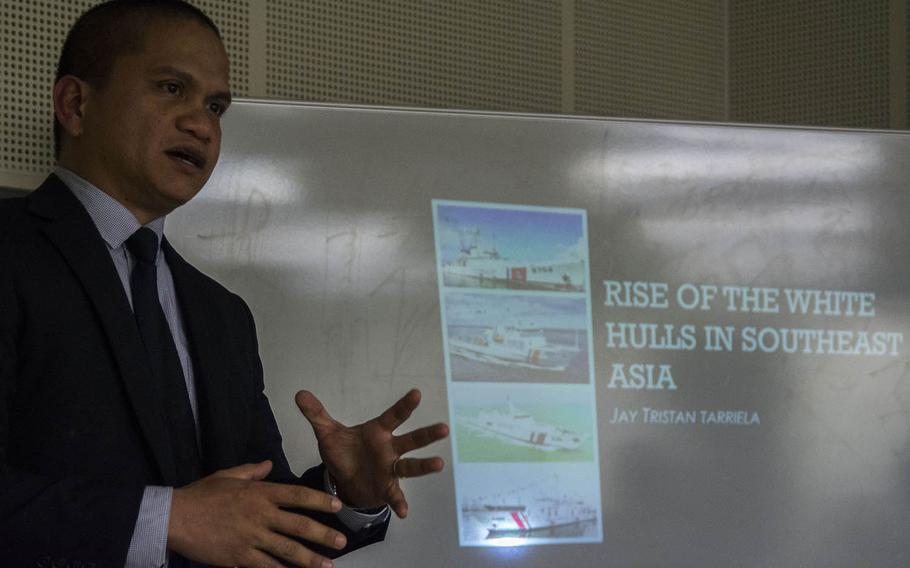
Lt. Cmdr. Jay Tarriela of the Philippine Coast Guard speaks about the increasing numbers and missions of coast guards in the region during a Yokosuka Council on Asia-Pacific Studies meeting in Fussa, Japan, April 18, 2019. (Theron Godbold/Stars and Stripes)
TOKYO — Nations in the Indo-Pacific region are employing “white hull” diplomacy, putting their coast guards to work to challenge China’s territorial claims at sea, a Philippine Coast Guard officer said recently.
Lt. Cmdr. Jay Tarriela described the growing strength and responsibility of coast guards in the western Pacific on April 19 while speaking to the Yokosuka Council on Asia-Pacific Studies near the home of U.S. Forces Japan.
“The rise of white hulls in the region has seen a noticeable uptick since the early 2000s,” he said.
Smaller Asian nations are responding to territorial challenges from China with their coast guards, rather than their navies, said Tarriela, a post-graduate student at the National Graduate Institute for Policy Studies in Tokyo. That lower level response reduces the likelihood of a shooting war breaking out.
“Someday, somebody might make some mistakes and there will be a fight,” he said, quoting Malaysian Prime Minister Mahathir Mohamad. “Some ships will be lost and there might be a war and we don’t want that.”
Tarriela focused his studies on the Philippines, Vietnam, Malaysia and Indonesia, countries that contend with conflicting territorial claims by China in the South China Sea.
“[The] China trend is a reason why the coast guard is getting bigger, but only in the last decade,” he said. However, “there are more important tasks for the coast guard.”
Coast guards should focus on search-and-rescue duties, law enforcement and environmental issues, he said, not duties that are more in line with a military mission.
However, China’s rising interest in the region accounts for most of the increasing coast guard presence, Tarriela said.
“Smaller ships should be the ones patrolling [the] South China Sea” he said. “Smaller countries need to patrol their own territories.”
China is a major trading partner for many Asian countries, which puts them in a precarious position in the region, Tarriela said. They don’t want to antagonize China with naval vessels, so they use smaller coast guard vessels, which are not technically military vessels.
The role of coast guards in the region today evolved from the model started by Japan in the 1960s, Tarriela said. The Japanese government used its coast guard to build regional goodwill and cooperation in four phases, he said.
First, the lighthouse-building phase, in which Japan built lighthouses and mapped the Straits of Malacca, the 550-mile-long body of water between the Malay Peninsula and Indonesian island of Sumatra. The strait is a major shipping channel that connects the Pacific and Indian oceans.
In the mid 1970s, after the Japanese tanker Showa Maru spilled oil into the Singapore Straits, the Japan Coast Guard shifted to an environmental protection role, teaching other nations’ coast guards the proper response to those types of events, Tarriela said.
In the early 2000s, with a rise in piracy, the emphasis shifted to law enforcement. Japan, still suspect in the eyes of neighbors who remembered World War II, adapted its approach to train the coast guards of the Philippines, Malaysia, Indonesia and Vietnam.
Finally, Tarriela said, comes a security phase that marks the emergence of territorial claims by China in the East and South China seas, claims that often overlap those of the four countries.
godbold.theron@stripes.com Twitter: @GodboldTheron